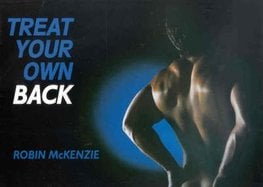Treat your own back Download treat your own back or read online here in PDF or EPUB. Treat Your Own Back Videorecording Based On The Book Treat Your Own Back By Robin Mckenzie 2010. Author by: Robin. Drug free and empowering the patient for lasting results.Treat Your Own Back & Treat Your Own Neck have been awarded Gold Bestseller.
- Treat Your Own Neck By Robin Mckenzie Free Download For Windows 7
- Treat Your Own Neck By Robin Mckenzie Free Download For Mac
Treat Your Own Neck by Robin McKenzie is a brief book that describes how to ease your neck pain with simple exercises and posture fixes. The book covers a number of common activities - sitting, driving, manual labor and reclining - showing the wrong way and the right way to do them, and why. It also presents an exercise program and clarifies how to use it depending on the level and timing of your pain. McKenzie is a physical therapist whose research suggests that a process known as centralization - when pain moves from the periphery of the body toward your spine - is an indication your treatment is working.
Pros
- The McKenzie Method has an excellent reputation.
- Simple, clear easy to follow instructions.
Cons
Treat Your Own Neck By Robin Mckenzie Free Download For Windows 7
- None
Publication Information
- Treat Your Own Neck by Robin McKenzie
- Published by Spinal Publications, Waikanae, New Zealand.
- 63 pages.
- Last Publication Date August 2003.
- A do it yourself approach to managing most types of neck pain.
- McKenzie is a physical therapist and his method is well known in the orthopedic world.
Quick Summary
Treat Your Own Neck By Robin Mckenzie Free Download For Mac
Treat Your Own Neck is for most, but not all, people with neck pain. The reason is that neck pain, according to McKenzie and others, is generally due to overstretching of soft tissue (particularly ligaments), which is something his program addresses. If your problem is due to something other than overstretched ligaments, you can read McKenzie's short list of symptoms (on page 22) that indicate the need for medical attention.
For example, if you have radiculopathy (pain and other symptoms going down one arm), you should see your doctor before attempting the exercises in the book.
In fact, McKenzie recommends that the first time you get neck pain to have it checked by your doctor. A doctor, he says, will examine your neck from a number of medical angles. After you understand the problem, you can then determine your best course of action. This may include fitting the Treat Your Own Neck program in with other care options, if it's appropriate to your situation.
That said, McKenzie puts the onus of neck health on the reader. 'The management of your neck is your responsibility,' he states in his introduction.
The Problem From McKenzie's Perspective
McKenzie says that overstretching of soft tissue precedes tissue damage. This may lead to problems ranging from forward head posture to bulging and herniating discs. Again, if you have a disc problem you should work with your doctor to establish the best treatment for you.
One of the main neck issues addressed in this book is the protruded or forward head posture. McKenzie says it is a result of the events that occur in the spine during sitting. The neck muscles that hold your head up on top of your spine get tired, and the neck gradually protrudes forward. In this way, support for your neck is lost.
How McKenzie Presents His Exercises
Each exercise takes two pages to describe, with text on the left and black-and-white photos on the right. For every description, McKenzie explains how to move out and how to come back to the start position. He tells you how many times to repeat the movement, and how often during the day to do the exercise. This varies according to the way in which the exercise is used. For example, the cervical retraction exercise, he says, is used mainly to address neck pain, but you can also use it for prevention. When addressing existing pain, McKenzie suggests doing 10 reps about six to eight times each day. For prevention, all you need is five to six reps, as needed.

Chapter 5 talks about different types of pain, such as headaches, recently subsided pain and acute pain, and how to choose exercises for each.
Our Take
At first glance, Treat Your Own Neck seems like a one-cure-fits-all type of book. But knowing McKenzie's excellent reputation in the spinal treatment world, we challenged our first impressions as we delved more deeply into the book. Sure enough, there are specific, credible guidelines on everything from how to choose exercises for different pain scenarios and techniques for modifying strength exercises if stiffness is your main problem to signs indicating you need to be working with your doctor rather than, or in conjunction with, the Treat Your Own Neck program.